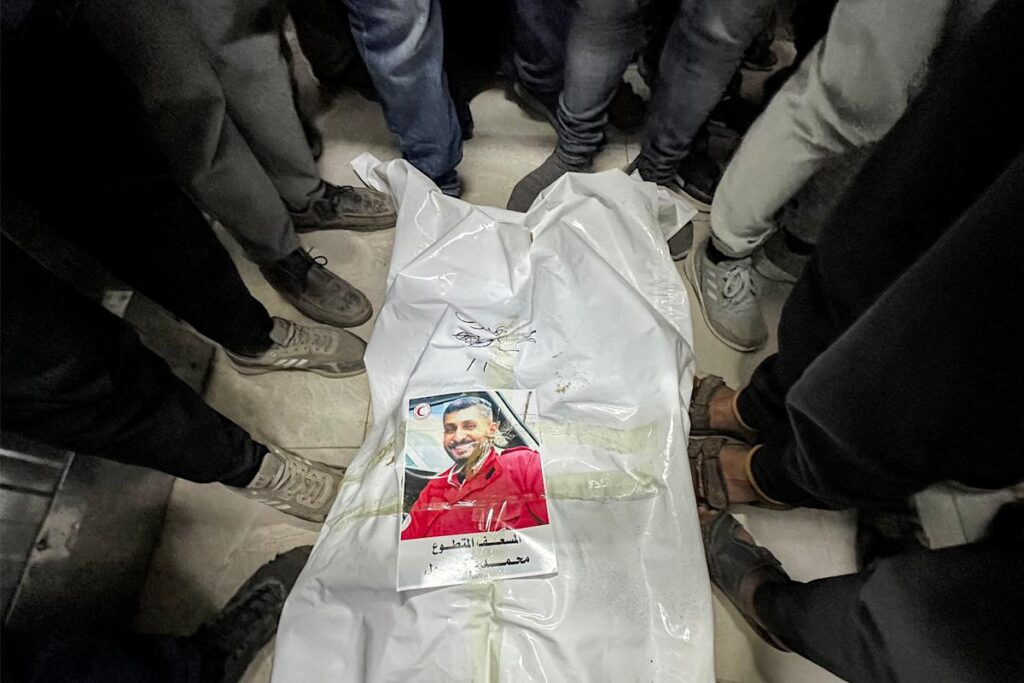TEL AVIV —The Israeli Defense Forces faulted a series of “professional failures” and “breaches of order” in the incident last month when Israeli soldiers killed 15 Palestinian aid workers in Gaza, an event that sparked widespread condemnation and calls for an independent investigation.
In the summary of an internal report on the killings and a briefing to foreign media Sunday, the IDF said it “regrets the harm caused to uninvolved civilians” and announced that it had discharged the field commander leading the implicated unit and formally reprimanded a senior officer.
The report and the IDF’s rare acceptance of blame were the culmination of a weekslong scandal that had heaped further criticism on Israel’s military just days after it broke a two-month ceasefire agreement with Hamas and restarted its offensive in the Gaza Strip.
The controversy around the killings worsened after United Nations personnel recovered the bodies from a shallow mass grave near the scene of the incident on March 23, and cellphone video found on one of the corpses revealed serious inconsistencies in the IDF’s original version of events.
“It’s like a chain of professional mistakes but with no ethical gaps,” Brig. Gen. Ephraim Defrin, said the newly appointed IDF spokesperson, in a presentation to reporters Sunday evening. “There was never any intention to deceive the public.”
Some initial reports from Palestinian examiners claimed that some of the medics had been found with their arms bound. However, other Palestinian medics said there was no evidence that the medics had been restrained before they were shot execution-style, a claim the IDF also denied.
The Palestine Red Crescent Society said in a statement after the bodies were found that the targeting of the medics “can only be considered a war crime punishable under international humanitarian law, which the occupation continues to violate before the eyes of the entire world.”
The aid workers included paramedics, civil defense staff members and a U.N. employee.
Israel previously said its soldiers shot and killed people they considered to be “terrorists” who were “advancing suspiciously.” The IDF also claimed that vehicles that were approaching its position lacked headlights or emergency signals. At the time, Israeli forces reported that they killed nine militants from Hamas and Islamic Jihad.
The military later walked that back after video from the Palestine Red Crescent challenged its version of events. NBC News reviewed video from the phone of a paramedic who was killed, showing an ambulance with its headlights and emergency lights flashing at the moment the soldiers opened fire. The vehicle was clearly marked with the insignia of the Palestine Red Crescent Society. Flashing lights from two other vehicles are also visible in the video.
The investigation revealed “several professional failures, breaches of orders, and a failure to fully report the incident,” the IDF said.
But the public report and the presentation, which retired Maj. Gen. Yoav Har-Even, who led the presentation, said were conducted “outside the chain of command,” did not answer all of the questions surrounding the shootings. It did not provide evidence to back up the Israeli military’s contention that six of the 15 slain emergency workers were actually Hamas operatives, nor did it explain why the number of slain medics whom the IDF considered terrorists had changed.
The report and the presentation also left it unclear why one of the surviving medics, Asaad al-Nassasra, was detained by the IDF and still remains in its custody.
Alongside the report summary, Har-Even showed a video presentation that featured aerial surveillance of the early-morning shootings, including night-vision reconnaissance video.
The probe found that troops were hampered by poor visibility and that they misidentified ambulances and rescue vehicles as threats during a mission targeting Hamas operatives, according to Sunday’s report. Har-Even laid partial blame on the soldiers’ night vision goggles for leading to what he called the “tragic and undesirable result of a complex combat situation.” The goggles’ limited peripheral perspective, among other factors, made it difficult for the soldiers to recognize the trucks as civilian emergency vehicles despite their flashing emergency lights, he said.
Another strike on a U.N. vehicle resulted from a breach of operational rules, the IDF’s report says.
The field commander in charge of the operation on the ground, whom the report did not name but whom IDF public relations officers identified as a major, was dismissed in part for “providing an incomplete and inaccurate report during the debrief.”
The commanding officer of the 14th Brigade received a formal reprimand that will appear in his personnel file, the report summary said, both because of his “overall responsibility” for the shooting and his “management of the scene afterward.”
This article was originally published on NBCNews.com
Read the full article here
